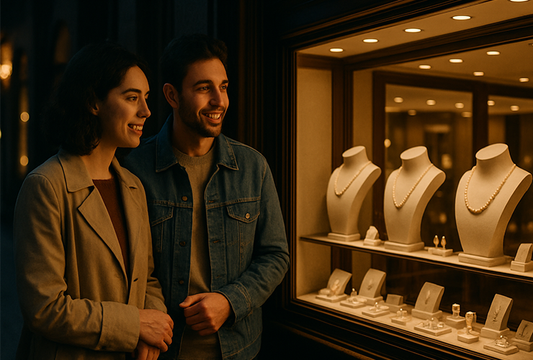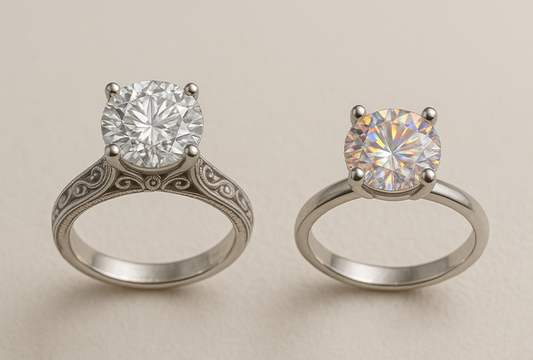Diamonds — they're nature's marvels and humankind’s muses.
While their sparkle is legendary, a less-understood characteristic adds a curious charm to these gems: fluorescence.
In this article...
What Is Fluorescence in a Diamond?
Diamond fluorescence refers to how much a diamond glows when inspected with long-wave ultraviolet (black) light.
You may have heard mixed reviews about diamond fluorescence — some say it enhances a diamond's color, others believe it's a deal-breaker.
Fluorescence is a diamond’s natural phenomenon that can play to your advantage, offering more sparkle for your dollar.
In this blog, we’ll guide you through its mystic light and help you decide whether a fluorescent diamond is the crown jewel of your collection.
Whip out those UV lights - it’s time to shine!
Understanding Diamond Fluorescence
The Science of Glow
When long-wave Ultraviolet light hits the diamond, electrons get buzzed and jump to higher energy states.
Once they return to their normal state, they release energy in the form of light — fluorescence.
Technically speaking, the UV light passes through the diamond in an “excited state” and leaves in a “relaxed state,” which exits the gem as a fluorescent wavelength.
Don’t get us wrong, fluorescent diamonds won’t give the disco balls a run for their money, but they will shine with a soft glow.
Or, in other words, they fluoresce!
Daylight Diamonds
Diamonds aren’t the only stars stealing the spotlight; our Sun is an Ultraviolet ray factory that sees that glimmer you’re wearing.
In broad daylight, a fluorescent diamond can throw out a blue light that makes it appear whiter.
Don’t expect your fluorescent diamond to give Thanos a run for his money. The glow remains soft even if the color does alter somewhat.
Some people love the way fluorescent diamonds react to UV light. But here's the kicker — this effect vanishes when the UV source is out of the picture.
Why Do Diamonds Fluoresce?
Diamonds are formed from crystalized carbon particles from the depths of the earth long before you or I ever considered wearing them as jewelry.
Diamonds aren’t formed (or designed, for that matter) to be picture-perfect for human wearers.
Diamonds are simply the result of particle alchemy up to 125 miles beneath the surface.
You’ll usually find natural diamonds hiding beneath volcanic sites (or ancient volcanic sites still hitting the snooze button).
Now, unless you’re Martha Stewart, you can’t be giving Mother Earth a hard time for letting the odd rouge mineral get in the diamond mix. Boron, to be exact.
Boron is the mineral responsible for getting caught up in the diamond crystallization process and resulting in, you guessed it, diamond fluorescence.
The diamond fans who don’t subscribe to the less-than-perfect diamond mantra see fluorescence as a defect.
To us, all diamonds are perfect in their own way!
Prevalence of Fluorescence in Diamonds
Do All Diamonds Fluoresce?
You might think fluorescence is a rarity, but it's more common than you’d think.
Studies suggest a significant portion of diamonds have some level of fluorescence, but not all will throw a blue rave under UV light.
Fluorescent diamonds are so common that gem experts estimate that around 50% of natural diamonds are fluorescent, with just 10% of those having noticeable fluorescence.
The Spectrum of Light
Blue might be the most common color of fluorescence, but diamonds can be the rebels of the gem world, showing off yellow, green, white, or orange fluorescence.
These unique light shows speak volumes about the diamond's inner characteristics.
It's almost like gazing at the constellations of stars in a galaxy - the perception and depth of light used by those viewing a diamond reveal the accurate picture.
Grading Diamond Fluorescence
A Different Scale
Before diamond certifications were determined if your gems were Ivy League, Europe couldn’t get enough diamonds that shone with an icy blue-white hue.
Fast forward to the more aptly eyed 1970s diamond dealer era, and people started to notice these once glittering gems appeared to have a hazy quality.

Photo: (Top) Maha Tannous / GIA, (Bottom) Harold & Erica Van Pelt
Color grade D, very strong blue fluorescence, and low transparency?
You’ve got a “milky D” - modern translation, milky diamond.
Aside from knocking the diamond’s self-esteem, this nickname also knocked the price tag well below the gem’s value.
Even diamonds with the color grade F weren’t safe from the fluorescence mutiny.
GIA Fluorescent Diamond Grading
Our trusted friends at the Gemological Institute of America have clarified the scale to clear up historical arguments surrounding these diamonds.
In 1997, they said, “Enough’s enough,” and did some controlled experiments surrounding the appearance of fluorescent diamonds in different light conditions.
They argued that most jewelers and diamond wearers would only be viewing their gems “table up.”
Therefore, this is the only view that truly matters. But they still covered all bases.
When diamonds of all fluorescence levels were viewed “table down,” the GIA revealed no widely perceptible change to the diamond’s color.
Even more shocking was when viewed “table up,” diamonds on the Strong and Very Strong scale appeared to have better color - especially for I-K colors!
These days, unlike the 4Cs (Cut, Color, Clarity, Carat), fluorescence is measured on a scale from 'None' to 'Very Strong'.
The GIA diamond fluorescence scale goes as follows:
- None (no fluorescence)
- Faint (tiny bit of fluorescence)
- Medium (might notice the fluorescence)
- Strong (will likely see fluorescence)
- Very Strong (get your sun shades out!)
Okay, the above grading by the GIA considers how noticeable the fluorescence is, but it's not just about intensity; the hue also matters.
Color Commentary
While a diamond’s fluorescence may not make or break the GIA’s reporting, they will note its color if it exhibits strong fluorescence.
Why is this important? It’s crucial info that can still affect a diamond's appearance.
Blue fluorescence can mask yellow tones, while yellow fluorescence might taint that oh-so-icy appearance many look for in a diamond.
Even though the GIA’s study proved that the perceptive shift in color is incredibly rare, it’s not an absolute zero.
Therefore, it’s always worth checking your diamond’s grading thoroughly to ensure it is exactly what you dreamed it to be!
Fluorescent Impact on Diamond Appearance and Value
The Beauty and the Fluorescence
Some experts say fluorescence makes a lower-color diamond look whiter in the sun, but there's a catch.
Strong fluorescence can sometimes give a diamond a milky look (remember Milky Ds?), so seeing it with your own eyes is essential before buying.
There are diamond experts who counter GIA’s arguments by noting their use of lab lights with small amounts of UV while grading.
Due to this, it has been thought that diamonds may get a higher grade than they deserve because the fluorescence hides the true color!
But as the GIA’s study reveals, this isn’t the case.
And we mean, they’re the pros at diamond grading - they strenuously check each diamond's inclusions, sparkle, and hue to ensure their report is as true as possible.
Market Mysteries
The Value Tale of Fluorescent Diamonds is a detective novel you can’t stop turning the pages of.
Fluorescent diamonds are often priced lower than their non-fluorescent counterparts, but the difference isn't always proportional to fluorescence intensity.
While no two diamonds are exactly the same, no two views on fluorescent diamonds are ever precisely aligned either!
Many fluorescent neigh-sayers believe these diamonds aren’t as “pure,” but maybe arguments of purity should be left in the previous century.
However, you might not be over the moon if you discover your diamond has a cloudy, not-so-sparkly hue - especially if you paid for a flawless or colorless diamond.
But if your fluorescent diamond radiates beauty in your eyes and you’ve gotten exactly what you paid for (and more!), why reject them for not being flawless?
A lower-color-grade diamond might shine even brighter because of its fluorescence.
A diamond’s value varies depending on demand, quality, rarity, and the 4Cs! Exact values are hard to estimate and can change daily.
If you are happy to sport a fluorescent diamond, you can save yourself anywhere from 1% to 15%, depending on its fluorescent scale.
You would need to factor in all the above grading factors for your diamond, but people looking for a higher clarity tend to avoid stronger fluorescence.
If the diamond’s fluorescence doesn’t bother you, you might be able to bag yourself a higher-grade diamond for less or spend some of the cash saved on your honeymoon or vacation!
Ultimately, a diamond’s true value is determined by YOU.
Choosing a Fluorescent Diamond
To Glow or Not to Glow
Fluorescence in diamonds is a personal choice, like deciding what to wear daily or how to decorate your new house.
Some adore a fluorescent diamond's unique character, while others prefer their diamonds sans glow.
The best advice?
Check out the diamond in different lights to see if its fluorescence sings to you.
Speak to an expert jeweler and refer to your diamond’s GIA certification report.
Don’t let the neigh-sayers dull your sparkle if the diamond your heart is set on is right for you!
Assessing the Aura
Remember, fluorescence is just one part of each diamond's complex universe.
When selecting your diamond, consider all that makes it sparkle — the cut, color, clarity, and carat weight.
Think of fluorescence as the mesmerizing glow that can make your diamond's story more beautiful.
Luminous Decisions
Fluorescence is a fascinating feature that can benefit your aesthetic and financial advantage.
Is fluorescence in diamonds a bad thing?
It's subjective, but we like to think a diamond’s beauty is determined by its owner. It's all about how your diamond makes you feel.
Fluorescence is merely a marker of our enchantress Mother Nature. If you look around, very little in this world is perfect, but so much is awe-inspiring.
Ready to explore the radiant world of diamonds, fluorescence, and all?
Ben Garelick is here to light the way!
Visit our showroom or speak to our diamond experts online, and let's find the diamond that reflects your brightest dreams.

Peter Manka Jr. - Owner at Ben Garelick
Peter Manka Jr. is a passionate member of the family business who joined Ben Garelick in the early 2000s after working in product licensing for Sesame Workshop & The Jim Henson Company for many years. He obtained a degree in diamonds and jewelry from the prestigious Gemological Institute of America (GIA) in order to sharpen his jewelry skills. He takes great pride in providing exceptional customer service and helping clients find the perfect piece of jewelry.



